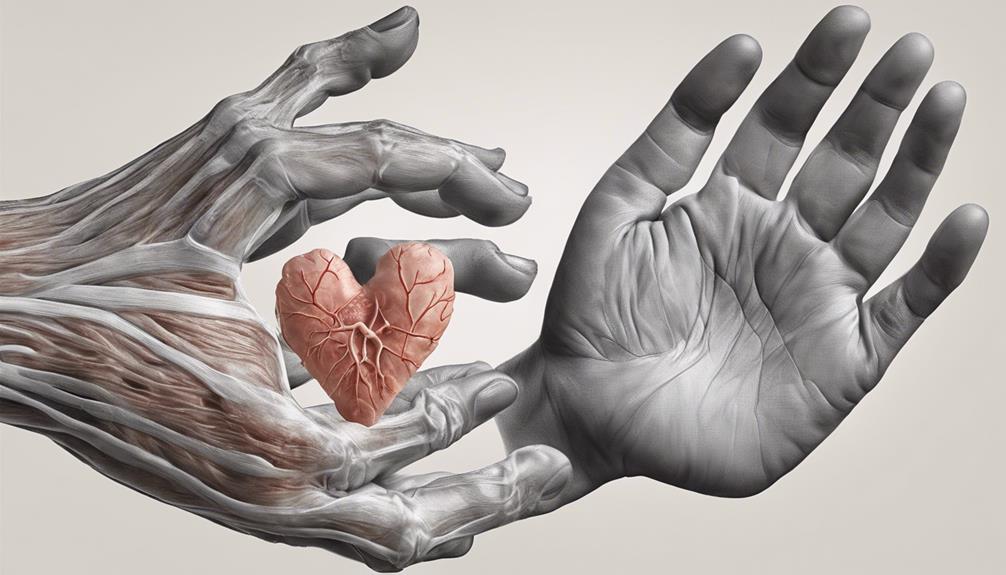Exploring the complex terrain of heart health, the link between ear creases and heart disease appears as a subtle hint in the background, suggesting there may be unexplored depths.
The subtle yet significant link between these seemingly unrelated areas beckons us to explore the mysteries that lie beneath the surface, offering insights that could potentially revolutionize our approach to heart health.
Key Takeaways
- DELC is linked to CAD.
- Bilateral complete DELC indicates higher CAD risk.
- DELC can aid in early CAD diagnosis.
- Recognizing DELC enhances cardiovascular risk assessment.
Historical Background and Discovery
In 1973, Dr. Sanders T. Frank first described the diagonal earlobe crease (DELC), now known as Frank's sign, which has since been linked to coronary artery disease (CAD) and peripheral vascular disease.
Frank's sign, initially observed in 20 patients with angina, raised suspicions of a possible association with CAD. Subsequent studies have solidified the connection between DELC and cardiovascular health, highlighting its potential diagnostic value.
The presence and severity of earlobe creases, particularly bilateral complete DELC, may serve as indicators of a higher risk for CAD and adverse cardiac events. Recognizing Frank's sign can aid clinicians in the early identification and diagnosis of coronary artery disease, potentially leading to improved patient outcomes.
Understanding the significance of earlobe creases in the context of cardiovascular health underscores the importance of paying attention to subtle physical markers that can offer valuable insights into an individual's overall well-being.
Research Findings and Studies

Research findings and studies in the field of ear crease heart disease have consistently demonstrated a robust correlation between diagonal earlobe creases (DELC) and cardiovascular conditions, particularly coronary artery disease (CAD).
The association between ear lobe creases and CAD has been well-documented, indicating a potential link to vascular disease and atherosclerotic processes. DELC has emerged as an independent predictor of atherosclerotic disease and CAD outcomes post-intervention.
Various research endeavors have delved into the pathophysiological basis of earlobe creases, exploring their connection with traditional CAD risk factors. Diagonal ear lobe creases are considered a surrogate marker for impending ischemic heart disease (IHD), underscoring their significance in early detection and intervention strategies.
Understanding the relationship between DELC and CAD could pave the way for improved risk assessment and management of individuals at heightened cardiovascular risk, emphasizing the importance of recognizing this unique physical trait in clinical practice.
Clinical Significance and Diagnosis
Pivoting from the research findings on the correlation between diagonal earlobe creases and cardiovascular conditions, the clinical significance of identifying and diagnosing this physical trait lies in its potential to serve as a visible indicator for prompt evaluation of cardiovascular comorbidities. Recognizing the presence of a diagonal earlobe crease (DELC) can aid in the early diagnosis of conditions such as coronary artery disease (CAD) and peripheral vascular disease, ultimately leading to timely intervention and improved patient outcomes. Dermatologists and healthcare providers play a crucial role in utilizing DELC as a screening tool for cardiovascular risk factors and atherosclerotic disease. The presence of DELC not only serves as a CAD predictor but also highlights the need for further assessment for ischemic heart disease and other cardiovascular comorbidities. The table below summarizes the clinical significance of diagonal earlobe creases in the context of cardiovascular health:
| Clinical Significance of DELC | |
|---|---|
| Early Diagnosis of CAD | Visible Indicator |
| Prompt Evaluation | Atherosclerotic Disease |
| Cardiovascular Comorbidities | CAD Predictor |
| Improved Patient Outcomes | Peripheral Vascular Disease |
Potential Mechanisms and Theories

Our exploration of potential mechanisms and theories surrounding the association between ear lobe creases and heart disease delves into the intricate interplay of genetic factors and protein deficiencies underlying this intriguing correlation. One theory posits that the loss of elastin and elastic fibers in individuals with ear lobe creases mirrors the process seen in coronary artery disease, potentially contributing to the development of heart issues.
Genetic factors also appear to be significant, with studies suggesting a genetic link between ear creases and heart attacks that transcends different ethnic groups. Moreover, deficiencies in proteins like adropin and irisin have been implicated in linking ear lobe creases to atherosclerosis, a key player in heart disease.
Low levels of specific proteins and hormones, such as the age-suppressing Klotho hormone, have been found in individuals with earlobe creases and coronary artery disease, pointing towards a potential biochemical mechanism at play. Additionally, the susceptibility of end-arteries supplying the heart and ears to damage may contribute to the heightened risk of heart disease associated with ear lobe creases.
Implications for Heart Health
With the association between ear lobe creases and heart disease well-established, a deeper understanding of the implications for heart health is crucial for early detection and intervention strategies.
The presence of a diagonal ear lobe crease (DELC) has been linked to an increased risk of coronary artery disease (CAD) and peripheral vascular disease, serving as a potential marker for atherosclerotic disease.
Bilateral complete DELC, the most severe form, is associated with a higher risk of CAD and adverse cardiovascular events. Recognition of DELC by clinicians can facilitate early diagnosis of CAD, enabling timely interventions and management strategies to enhance cardiovascular health.
Understanding DELC as a risk factor for CAD highlights the importance of incorporating ear crease assessment into routine clinical examinations for comprehensive cardiovascular risk assessment. Identifying DELC early may provide crucial insights into underlying cardiovascular conditions, paving the way for proactive measures to promote heart health and prevent adverse outcomes.
Frequently Asked Questions
Is Ear Lobe Crease a Sign of Heart Disease?
Yes, an ear lobe crease can potentially be a sign of heart disease. Research has shown a correlation between the presence of a diagonal ear lobe crease and an increased risk of coronary artery disease (CAD).
This association is independent of other risk factors like age, gender, and smoking status. Early recognition and evaluation of this crease may aid in the early diagnosis and management of cardiovascular health issues.
What Is the Ear Sign of Heart Disease?
When considering the ear sign of heart disease, it's important to note that certain visible features like the diagonal earlobe crease (DELC) can potentially indicate an increased risk of cardiovascular issues. Research has linked DELC to coronary artery disease and other heart-related events.
Evaluating earlobe creases as part of a patient's cardiovascular risk assessment may provide valuable insights for clinicians. Understanding these connections can help us better serve individuals in managing their heart health.
How Accurate Is the Frank's Sign?
Frank's sign, also known as the diagonal earlobe crease (DELC), is considered a potential marker for coronary artery disease. Studies indicate that DELC is an independent variable and predictor of atherosclerotic disease.
While research has explored its diagnostic accuracy for chronic coronary syndromes, results vary in sensitivity and specificity. Combining DELC presence with other risk factors may aid clinicians in early detection of coronary atherosclerosis.
What Does a Crease in Your Ear Mean?
When we notice a crease in our ear, it can serve as a potential indicator of various health concerns. The presence of an ear crease may hint at underlying cardiovascular issues, prompting further evaluation by healthcare providers. This visible marker could lead to early detection and management of conditions like heart disease.
It's essential to consider all potential risk factors and markers, including ear creases, to prioritize our cardiovascular health.
Conclusion
In conclusion, the presence of ear crease heart disease, or Frank's sign, serves as a visible marker of potential cardiovascular health risks. Research has shown that individuals with this diagonal ear lobe crease may have a higher likelihood of developing coronary artery disease.
With up to 80% of heart attack patients exhibiting this sign, early recognition and intervention are crucial in managing heart health and reducing the risk of cardiovascular diseases.










